Firearms that discharge multiple projectiles at once have been around since the blunderbuss and fowling pieces of the 1600s and beyond, used for hunting birds as well as war. The basic concept of the modern shotgun isn’t so modern; witness the iconic Winchester Model 1897 pump-action shotgun from the late 1800s.
They’re simple, reliable smoothbores that shoot shotshells, packed with everything from a clump of shot to a big honking slug. These days, rifles tend to drive social media clout, but shotguns remain a hugely versatile and powerful tool for delivering payloads on target — for hunting, recreation, self-defense, and tactical use. Arguably, the shotgun market has been experiencing a bit of a renaissance, with many companies releasing interesting new shotguns.
For its part, Mossberg has been steadily making guns for over a century, ever since 1919. Its shotguns line racks in military armories and police departments, not to mention defending homes and putting food on the table across America. It’s still family owned and operated to this day, in an often-chaotic industry full of mergers, acquisitions, and consolidation — not to mention bankruptcies.
Through the ages, there’s always been the great shotgun showdown, the battle between Remington and Mossberg. Three-digit bastions of smoothbore supremacy — 500, 590, 870. No matter which you favor, these are time-tested classics. But with Remington’s financial troubles and 2020 bankruptcy, their eye has been off the ball, even as it was finally split into RemArms for firearms and Remington Ammunition for ammo.
Mossberg has seized this opportunity and doubled down, now launching a slate of updated 12-gauge shotguns. They recently hosted a press event at Gunsite Academy in Arizona, where we ran them through the wringer.
ROTARY SAFETIES: 590R AND 590RM
One big advantage of Mossberg’s shotguns when fitted with traditional buttstocks is its top tang-mounted safety. It provides great ergonomics, as you can easily and positively flick on and off the safety with either thumb without shifting your firing hand.
This is of great benefit, for instance, in tactical situations where you need to frequently work the safety. Compare this to crossbolt safeties found on other shotguns, which you push from left to right or vice versa. Thus, disengaging the safety with your trigger finger is easy but re-engaging it requires breaking your grip.

Plus, while a crossbolt safety might be reversible with some effort, it’s not ambidextrous.
However, Mossberg’s top-mounted safety doesn’t work well with a pistol grip. Recently, Mossberg developed a sweet little breaching gun for a particular military requirement demanding AR-style ergonomics. As a result, they developed an AR-style rotating safety selector, which they’re now rolling out to their commercial 590 line with the new tube-fed 590R and box-fed 590RM.
These models feature pistol grips with the new safety, sporting an 18.5-inch barrel with a one-piece heat shield, cylinder choke, and with or without a breaching muzzle. The receiver is aluminum with a top Picatinny rail. Before you start to protest, don’t worry, the barrel-to-bolt lock-up is steel-on-steel goodness. The top rail height relative to the buttstock is similar to an AR, so AR sights and optics will work well.
The versions with a plain barrel also have a short piece of Pic rail at the muzzle for a front sight; Mossberg ships them with Magpul MBUS 3 flip-up sights.
The safety is similar to an AR, rotating 90 degrees with levers in a contrasting silver color on both sides. Below on the left side is the bolt release, optimized for the pistol grip and extended to avoid breaking your grip. Righties can hit it with their thumb; it’s easier for lefties, with their trigger finger. The trigger is flat with a small hook at the tip of the shoe, breaking cleanly at 4.75 pounds.
The stock adapter is one-piece steel-reinforced polymer, accepting most standard AR grips and Mil-spec-diameter AR buttstocks. There are QD sling cups on either side, as well as shields to prevent inadvertent
activation of the safeties. The guns come with a Magpul MOE pistol grip and Mossberg’s own buttstock with a hefty recoil pad.
The tube-fed 590R holds six rounds and has an enlarged, beveled loading port with an extended follower. Mossberg’s pump guns were already easier to load without an elevator in the way, and this makes it even nicer. The mag-fed 590RM has a new AK-style release lever and an integrated magazine guide for you to rock n’ lock the magazines.
They’re very robust and available in 5-, 10-, 15-, and 20-round capacities. When we’re talking about shotshells, that’s an awful lot of weight, but it can actually balance better since it’s all in the centered. The mag tube end cap secures a polymer M-Lok adapter with slots on both sides.
The forend is a brand-new design. The 500 and 590 have traditionally had an action slide tube assembly that rides on the mag tube; it’s robust but has side-to-side play and can scratch mag tubes.

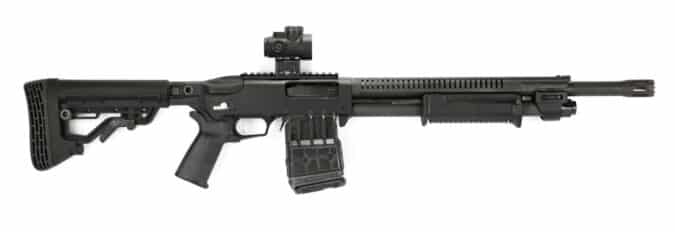
The new system consists of a compact new forend, two action slide bars, and a glass-filled nylon retention clip. It reduces lateral movement and is simpler, both in design and manufacturing, thus reducing upfront and maintenance costs when action bars need to be replaced. It isn’t backward-compatible, so aftermarket forends will unfortunately need to be redesigned. Mossberg intends to roll out the new design to 500s and 590s in the future, though not to the Mil-spec 590A1.
The new safety system worked well on the range, feeling AR-like and solving a problem we’ve always had with pistol-gripped shotguns. The recoil pad is excellent, making recoil very manageable. The trigger is great, and the gun was accurate with slugs, printing a loose cloverleaf at 25 yards.
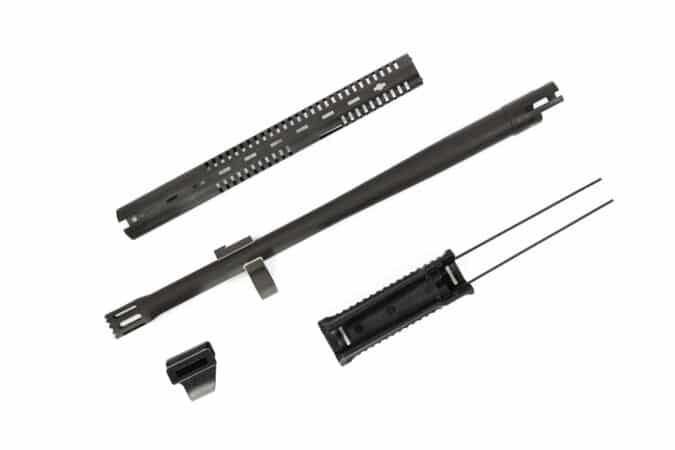
While we didn’t experience this issue, a number of other guys on the line found their trigger fingers getting banged up under recoil by the ambi safety lever on that side. Also, when trying to speed up, we discovered a slight short stroke can cause a double feed on the 590RM; to clear a double feed, you generally need to retract the action, remove the source of ammo, cycle the action, and ensure the gun is clear before loading it again. This process is more straightforward with the 590M than an AR.
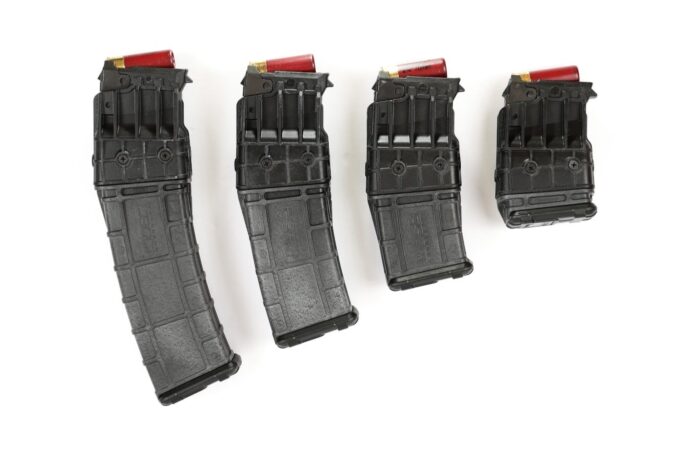
PROFESSIONAL SERIES
Mossberg has a long history of supplying guns to law enforcement and the military. With Remington’s troubles, they decided to really lean into this and invest in a new product line dubbed the Mossberg Professional Series. These guns are purpose built for hard duty use, all receiving an enhanced level of assembly and quality control that’s been required for their military contracts.
Given their intended purpose, all Professional Series guns share some key characteristics. First, they come with short buttstocks that are optimized for low cheek rise. Why so short? Agencies purchase shotguns that will be issued to officers of all sizes. Everyone can shoot shotguns with short stocks, even big people, but little people can’t handle long buttstocks. That said, you can install a spacer to increase the length of pull as needed. The buttpad is specifically tailored for a shotgun, with a rounded top and pointy bottom; the top clears your armor and the toe engages your shoulder pocket.
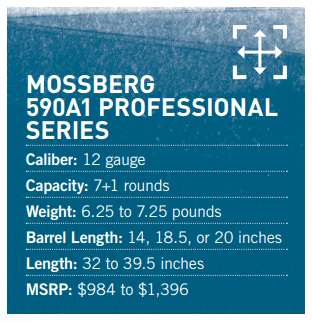


Secondly, they came up with very low profile, fixed, metal ghost ring sights with a bright fiber-optic insert up front. Both front and rear have protective wings and fit easily in tight racks. While folks tend to want adjustable sights, in practice they’re a common failure point on hard use shotguns and not all that necessary. Mossberg is confident in their barrels and not worried about windage — these aren’t rifled barrels and you’re shooting heavy payloads at relatively short distances.
Elevation varies based on velocity and weight, and these guns have been optimized for the ubiquitous Federal LE132 FliteControl buckshot and similar loads. Additionally, the rear sight can be unbolted to reveal an RMS-C/Holosun K optic cut, perfectly placing a red dot very low on the gun.
Finally, the guns are finished with Cerakote on the receiver, barrel, and magazine tube. Mossberg tested many options and concluded this provided the best results, and allowed them to apply it in-house for quicker turnaround and greater efficiency. That said, a couple variations of the 590A1 will be offered with electroless nickel Marinecote.
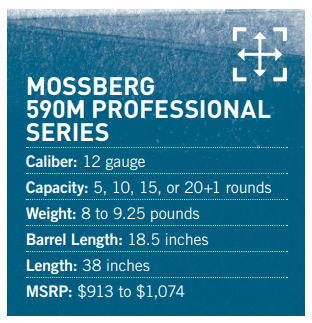
The new Professional Series includes a 590M mag-fed breaching gun, 590A1 pump-action, 590M mag-fed pump-action, 590A1 and 590M less-lethal guns, 940 Pro Tactical semi-auto, and MVP Patrol mag-fed bolt-action rifle. Here, we’re focusing on the 590 and 940 Professional Series guns.
While these guns aren’t being marketed to the civilian market, they’ll be available via commercial distributors, so you’ll definitely be able to purchase them.
590A1 AND 590M PROFESSIONAL SERIES
The tube-fed 590A1 and mag-fed 590M Professional Series are fitted with standard buttstocks and all the core features we outlined above. They’re offered with either Mossberg’s bantam buttstock and traditional “corncob” forend or Magpul furniture. The 590M only comes with an 18.5-inch barrel, while the 590A1 is available with a 14-, 18.5-, or 20-inch barrel. Magazine capacity of the latter is 5+1, 6+1, and 8+1 shells, respectively.
Note that the 590M Pro Series has the original AR-style push-button magazine release, rather than the new AK-style lever on the 590RM.
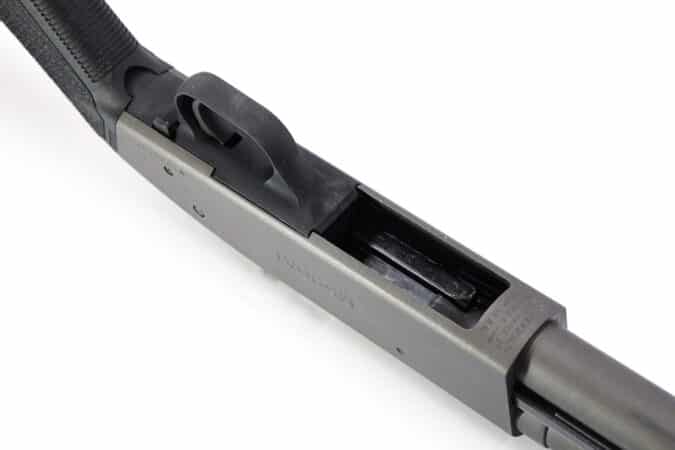
On the range, these shotguns deliver truth in advertising. They’re what you’d expect in a duty gun — tough and dependable. And they handle like the 500s and 590s that you’re used to. The new iron sights are great; they’re very low and feel natural for anyone who’s used to shooting traditional shotguns.
We’d prefer a smaller fiber insert in the front sight, though. Mossberg acknowledged this but explained that they ended up selecting a larger one for durability.
We patterned them and got great results with Federal FliteControl. Lacking the cushy buttpad of the 590R, these guns had quite a kick to them with slugs and full power loads. The trigger on our 18.5-inch broke at 6.75 pounds and our 20-inch at a hefty 7.75 pounds.
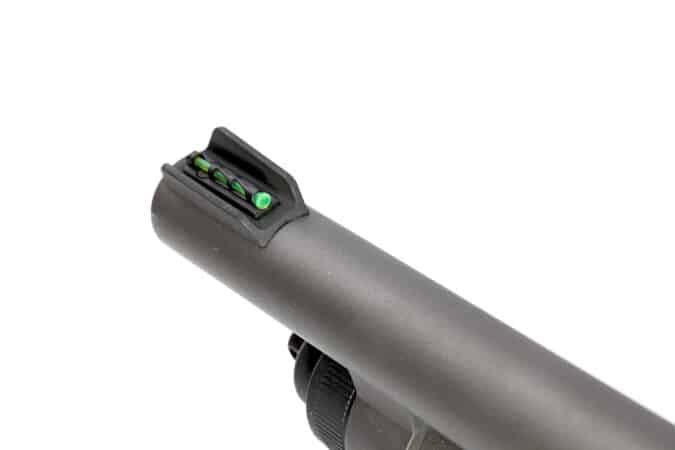
They weren’t our favorite, especially compared to the 590R and 940, but they got the job done and on Gunsite’s long, rolling courses of fire and in their shoothouses, we rarely noticed except on long slug shots.
940 PRO TACTICAL PROFESSIONAL SERIES
Four years ago, Mossberg launched the 940 semi-auto shotgun platform, starting with the 940 JM Pro competition shotgun. Since then, Mossberg has been refining and evolving it to incorporate everything they wanted in a fighting semi-auto shotgun, culminating in the 940 Pro Tactical Professional Series.
Like other Mossbergs, the 940’s receiver is aluminum with steel-to-steel lockup for the bolt and barrel. Internal parts are nickel boron coated. It’s drilled and tapped on top with a low optic cut, along with support for other footprints using adapter plates. It’s shipped with the same low-profile ghost ring sights as the other guns. Mossberg calibrates them for a 75-yard zero with Federal LE132 buckshot. The barrel is 18.5 inches long with a fixed cylinder bore, for best performance with modern FliteControl loads and no need for maintenance.
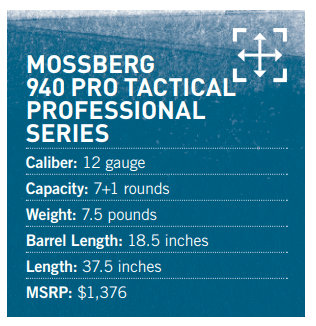

The loading port is hogged out and beveled, like the JM Pro race gun, with an extended orange follower and a longer elevator that won’t mangle your thumb. You can dual or quad load this shotgun if you want. Additionally, the charging handle is appropriately chunky and the bolt release has been revised so it’s oversized for easy activation but shielded to avoid snagging or hitting it accidentally.
The gas system has been tuned and optimized for fast and reliable cycling. The piston is a self-cleaning design, with a vented and stepped spacer tube and a recommended 1,500-round cleaning interval, though with ammo like buckshot you can go roughly twice as long.
The forend is all-new, slim laterally but taller vertically to act as a heat shield, for example if you flip the gun over to load it.
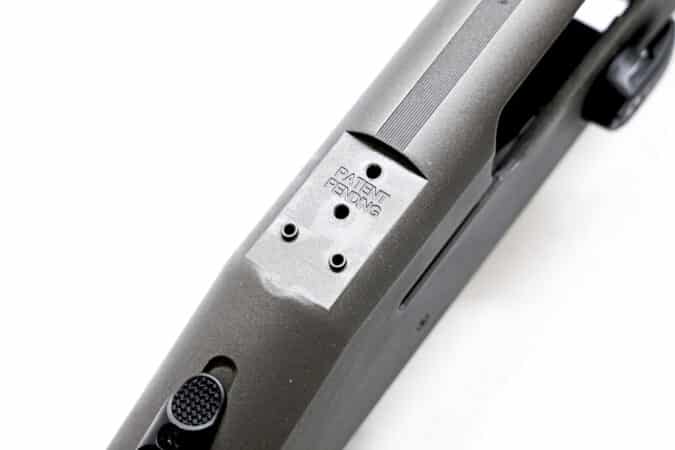
M-Lok slots are included at 3, 6, and 9 o’clock toward the muzzle end, while QD sling cups are on the left and right side closer to the receiver. This separation discourages your sling from interfering with your accessories. Note however that the new forend design is incompatible with a vent rib barrel.
Fit’s important with shotguns, and the 940’s buttstock can be adjusted for length of pull, drop, and cast. It has anti-rotation QD sling cups on either side and a swivel stud on the bottom.
The magazine tube is one-piece, so there’s no magazine extension to work loose.
It’s also nickel boron coated, and it has an aluminum rather than plastic external sleeve for durability and to prevent users from squishing the mag tube with barrel clamps (the gun comes with a polymer one with M-Lok slots for additional accessories, plus a step in the sleeve to prevent the clamp from sliding). The 940 has a bit of an underbite, as the magazine tube extends a bit past the muzzle, but we like the look and more importantly, this provides an inch of leeway so you can load the gun to full capacity even if your shotshells are longer than most.
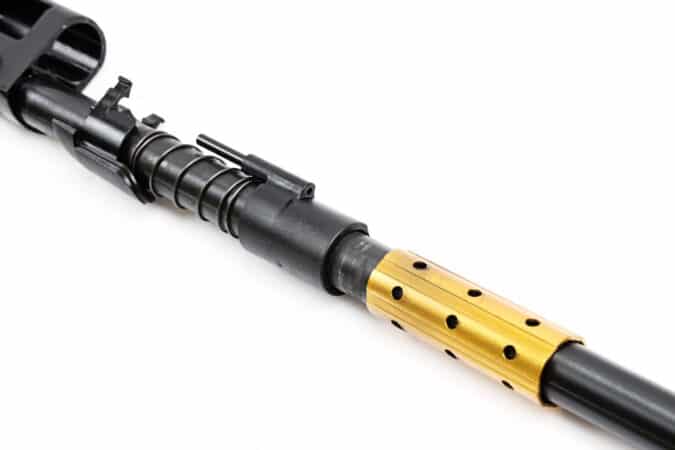
In our testing, the new 940 ran great. Ergonomics are good and all the controls are well-designed. A lefty in our group had no issues running the gun. The forend looks a bit odd at first but works very well, with contours in all the right places. As always, we loved the low optic cut, intuitively placing that red dot exactly where we wanted it every time.
The trigger broke nicely at 4.25 pounds, contributing to excellent results with slugs. We once again put cloverleafs down on paper and were able to walk back to 100 yards, consistently ringing steel with our 940. Recoil impulse was controllable and ripping multi-shot strings had us feeling like a Miculek.
The new 940 is a winner.
RACK EM UP
Whether you’re a Mossberg fan, team green, or usually prefer pasta, these are some of the best-designed shotguns Mossberg has ever fielded. The company has really listened to user feedback, dialed in these guns for their intended use cases, and paid great attention to detail in upgrading and improving their shotguns.
Gunsite always provides a great venue for running guns hard and bringing forth potential failure points. That said, we didn’t come close to the recommended 1,500-round interval on the 940, for instance, so we can’t really weigh in on that.
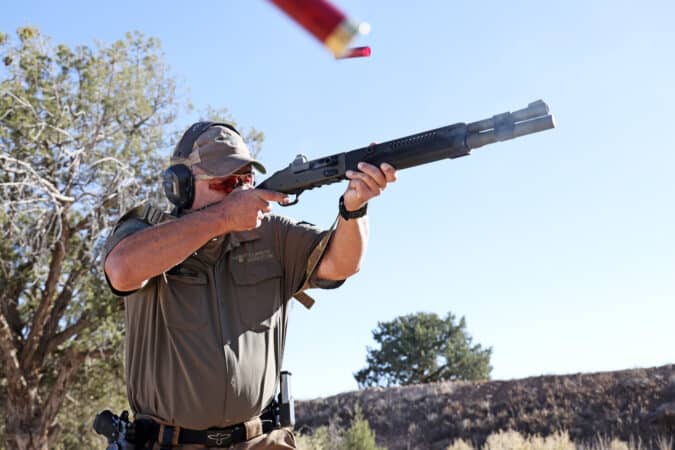
We can say that our sample guns ran great, were impressively accurate, and didn’t experience any malfunctions except for our own short stroke.
As we all bemoan inflation and rising prices across all aspects of life, Mossberg’s MSRP on these new guns is in four-digit territory, so where street prices end up will help determine how you weigh them against the alternatives.
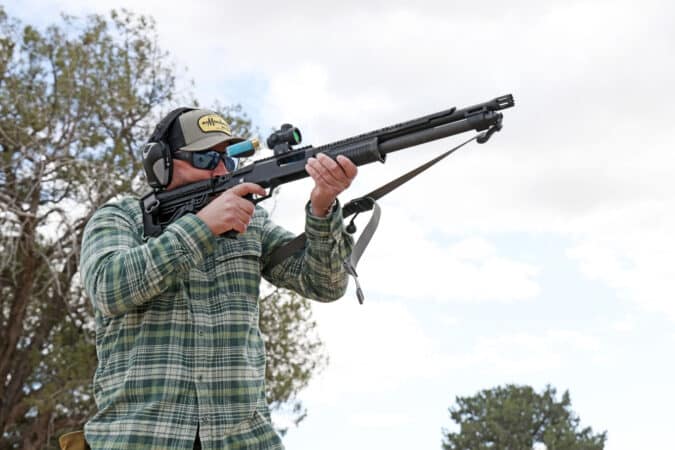
Nonetheless, the stringent quality control process being applied on the Professional Series guns certainly makes them appealing to provide a high level of confidence in a mission-critical shotgun for self-defense or on duty.
Mossberg’s stepped up their game for sure.
Read the full article here

![Mossberg Releases a Slew of Updated Shotguns [FULL REVIEWS]](https://gunreviewtactical.com/wp-content/uploads/2025/01/RECP-202503-MOSSBERG-OPENER-R51_8271-1200x675.jpg)
